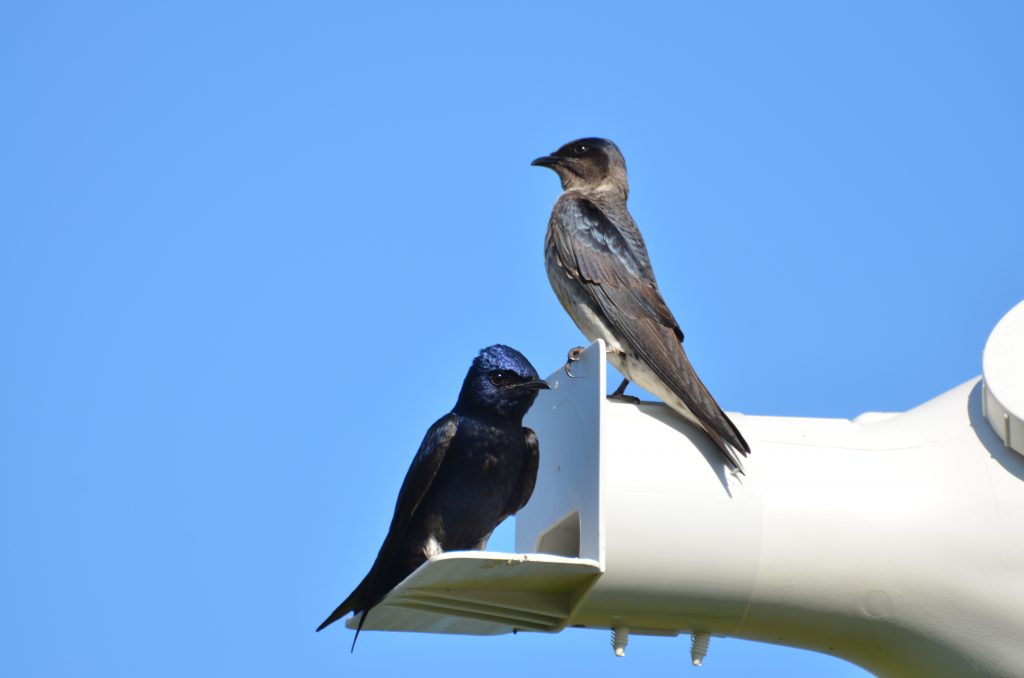‘Magic of nature’: Disney’s smart birdhouses reveal the secret lives of purple martins
Meet the Martins. The empty nesters have a little place near Orlando, though they also winter in Brazil. In their Florida home, the couple raised six kids amid the sunny strains of Disney songs. (Their children practically grew up at Walt Disney World Resort.)
The parents worked long hours to feed their big family, but they always served breakfast warm: dragonflies, crickets, moths and spiders.
That doting pair is part of a special community of hundreds of unique birds – purple martins – that reside in cozy birdhouses made just for them across the Walt Disney World resort.
The Martins resided in a small portion of a colony of nests within smart birdhouses – gourd-shaped enclosures outfitted by Disney and Microsoft with environmental sensors and HD cameras. They are the subjects of a new study that’s opening a window on the secret lives of purple martins – the largest members of the swallow family in North America and a species in decline.
To conservationists, purple martins serve as ambassadors for the majesty of migratory birds, and provide clues about what we can do to help protect them.
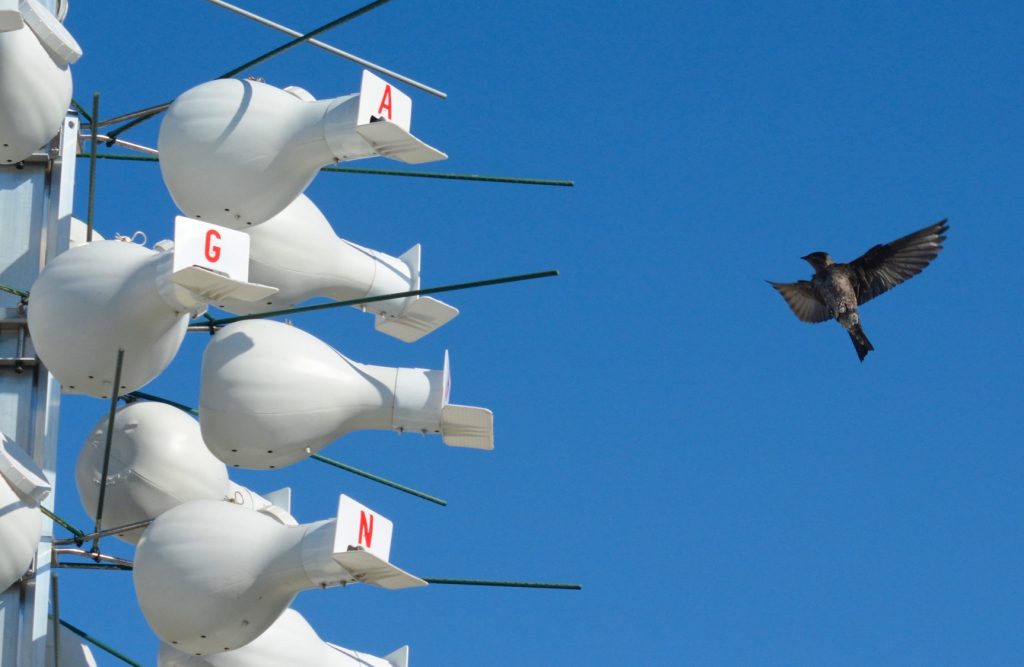
“Purple martins are amazing, so acrobatic and agile,” says Dr. Jason Fischer, conservation program manager for Disney. “They are only 8 inches long but that doesn’t hold them back from flying over 6,000 miles from the Brazilian Amazon to Walt Disney World and back every year.
“They are also cavity nesters, which means we can’t just watch what family life is like,” Fischer adds. “What happens in their nests has remained a mystery.”
Since 1966, the estimated count of purple martins in North America has cumulatively fallen by nearly 40 percent, according to Cornell University.
Worse, many types of migratory birds are waning in number, Fischer says.
Those trend lines helped to galvanize the purple martin project. It became part of ongoing collaborations between Disney’s Animals, Science and Environment team and global nonprofits striving to save imperiled wildlife, Fischer says.
“We at Disney want to create magic in new and exciting ways, while being good stewards of the resources around us,” says Tony Ambrozie, senior vice president of technology at The Walt Disney Company. “We knew we wanted to help the birds in a new and creative way.”
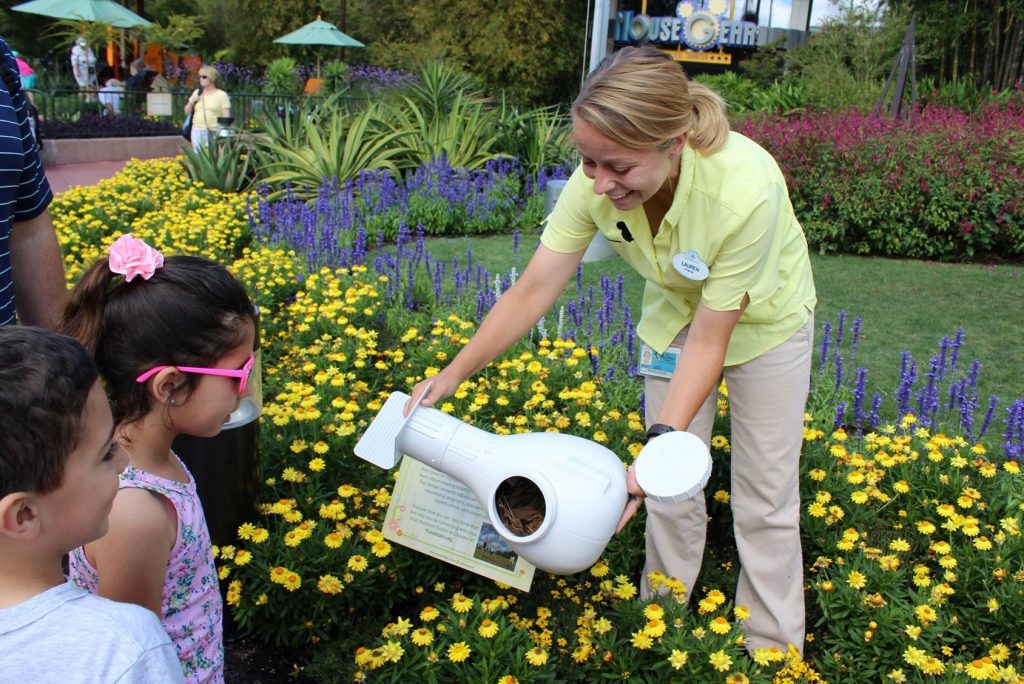
To learn more about the species and inspire guests to want to help them, the team first sought to answer some fundamental questions. What does it take to be a great purple martin parent? How do purple martin chicks learn what being a purple martin is all about? And how can they inspire Disney guests to be equally as enthralled by these birds?
They hatched a game plan. They would watch the purple martins as they raised their families. They had one big advantage in that pursuit: Purple martins prefer to nest in custom made bird houses.
While many species occasionally roost in birdhouses, it’s rare for an entire population to choose human-provided housing over natural nesting sites, Fischer says. In eastern North America, nearly all purple martins live in birdhouses and they’re very tolerant of people.
To learn more about the inner lives of purple martins in their birdhouses, Disney Emerging Technologies collaborated with Microsoft.
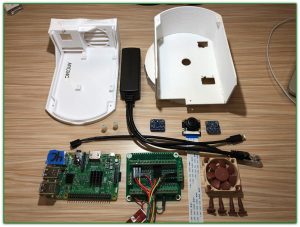

Together, this team built the first smart birdhouses for purple martins. These smart houses were added to a colony of gourd-shaped birdhouses mounted on a tall pole (nicknamed a “bird resort” by Disney conservationists). There are 11 purple martin resorts located at Disney’s Animal Kingdom.
Those birdhouses – white and about the size of a mailbox – are equipped with HD cameras and sensors linked to the cloud, making them some of the world’s tiniest smart homes.
The birdhouses combine the power of the intelligent cloud with the intelligent “edge” – in this case, the gourds – using computer vision, Microsoft Research’s embedded learning library and Azure IoT Edge to study the Martin family and send scientists fresh insights on their nesting behaviors.
All of that tech must withstand the Florida sun, humidity and rain – and not impact the birds and their family lives.
“We needed to ensure that the electronics-generated heat did not raise the internal temperature of the gourds in a way that could disrupt the purple martin nesting behaviors,” Ambrozie says.
To accomplish that, they equipped each sensor array with a noiseless fan. They also ran regular temperature tests on the cameras and other electronics gear to show that the tech was doing its job without being disruptive, Ambrozie says.
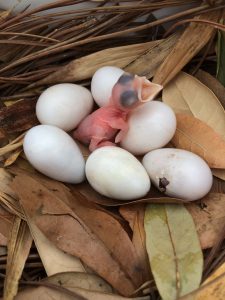
The study’s first phase was a proof of concept, showing the teams could construct welcoming, high-tech houses for purple martins. That box is checked, Fischer says.
Cameras affixed near the nests and on the birdhouse porches offered high-def views of chicks hatching from their eggs, and parents nurturing the offspring. The sensors, meanwhile, tracked temperature, humidity and air pressure throughout the nesting season – and recorded each time a parent entered or left the house.
“Watching them and listening to their upbeat chittering calls, it just seems like they have so much fun,” Fischer says. “This has the potential to excite so many families with the magic of nature.”
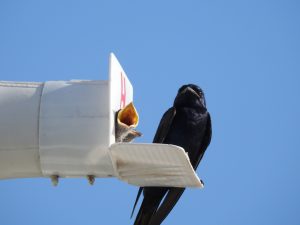
The smart birdhouses joined an existing, larger network of purple martin dwellings throughout the Walt Disney World Resort. Established for the study and conservation of the species, the community has provided homes for purple martin families for the past 20 years. It now consists of more than 170 nests each year.
“It has been an eye-opening experience to see how much we can learn about these birds, thanks to these new technologies,” Fischer says.
“Just as an example, when we could only watch the houses from the outside, I was always impressed by the size of the dragonflies that the parents took into the houses. We never knew if they gave that to one chick or more. But seeing (the new) video of the nestlings swallowing those huge dragonflies down is truly impressive!”

Next, Disney researchers hope to partner with Microsoft to improve and deploy more smart houses to discern similarities and differences among different purple martin families, Fischer says.
They’re also looking forward to a family reunion in early 2019 with the Martin family.
“There was one family we followed from eggs to empty nesters,” Fischer says. “Purple martins typically lay four to six eggs, and this was a large family of six. Every one of the eggs hatched and every chick survived to adulthood.
“We gave each chick a unique leg band when they were almost three weeks old. We can’t wait to see who comes back to Disney next year to raise a family of their own for the first time.”
Top photo: A pair of purple martins in a special community of hundreds of birds that reside in custom birdhouses across the Walt Disney World Resort. (All images courtesy of Disney.)

